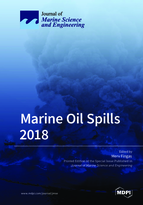Marine Oil Spills 2018
A special issue of Journal of Marine Science and Engineering (ISSN 2077-1312).
Deadline for manuscript submissions: closed (30 November 2018) | Viewed by 73409
Special Issue Editor
Interests: oil spills; remote sensing; oil spill behaviour and dynamics
Special Issues, Collections and Topics in MDPI journals
Special Issue Information
Dear Colleagues,
Marine oil spills have received a great deal of attention again since the Deepwater Horizon spill in 2010. Since then, there has been extensive research on various aspects of oil spills. The purpose of the invited Special Issue is to publish the most exciting research with respect to the above subjects and to provide a rapid turn-around time regarding reviewing and publishing, and to disseminate the articles freely for research, teaching, and reference purposes.
High quality papers are encouraged, for publication, directly related to various aspects, as mentioned below. Novel techniques for the study are encouraged.
- Topics—marine oil spills
- Fate and effects
- Analytical techniques
- Behavior and modeling
- Case studies
- Cleanup and countermeasures
- Effects on wildlife
Guest Editor
Manuscript Submission Information
Manuscripts should be submitted online at www.mdpi.com by registering and logging in to this website. Once you are registered, click here to go to the submission form. Manuscripts can be submitted until the deadline. All submissions that pass pre-check are peer-reviewed. Accepted papers will be published continuously in the journal (as soon as accepted) and will be listed together on the special issue website. Research articles, review articles as well as short communications are invited. For planned papers, a title and short abstract (about 100 words) can be sent to the Editorial Office for announcement on this website.
Submitted manuscripts should not have been published previously, nor be under consideration for publication elsewhere (except conference proceedings papers). All manuscripts are thoroughly refereed through a single-blind peer-review process. A guide for authors and other relevant information for submission of manuscripts is available on the Instructions for Authors page. Journal of Marine Science and Engineering is an international peer-reviewed open access monthly journal published by MDPI.
Please visit the Instructions for Authors page before submitting a manuscript. The Article Processing Charge (APC) for publication in this open access journal is 2600 CHF (Swiss Francs). Submitted papers should be well formatted and use good English. Authors may use MDPI's English editing service prior to publication or during author revisions.
Keywords
- oil spills
- fate and effects
- analytical techniques
- behavior and modeling
- case studies
- cleanup and countermeasures
- effects on wildlife






